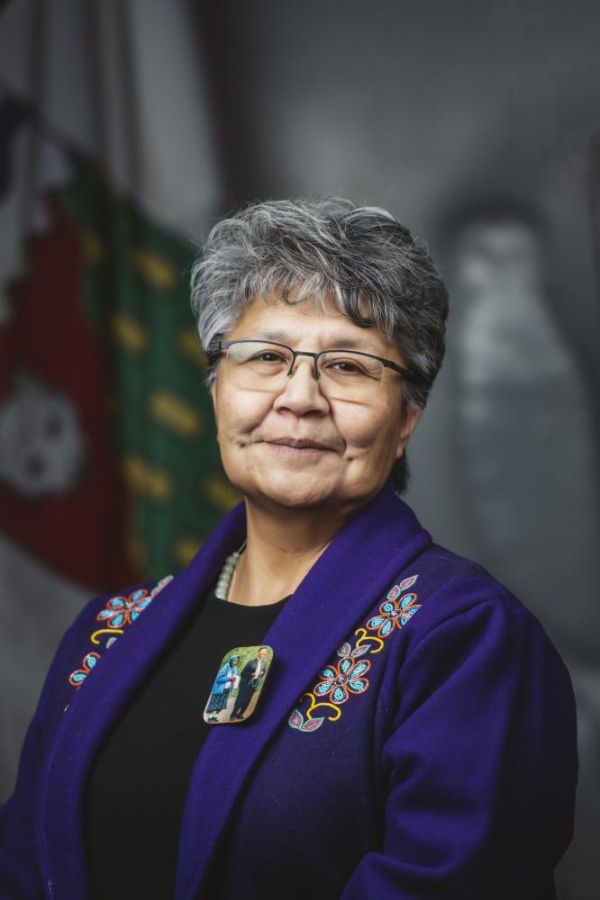
Thank you, Mr. Chair. And Mr. Chair, does the department anticipate that that maybe needs to change or evolve, or do they see that as working going forward? I guess sometimes I get a little bit concerned that there's a lot of whereas that we do want to breakdown the silos but there's a lot of times where, like, I hear, like, that ADMs or the deputy ministers are having all these committees and then it makes me wonder if they're just having a lot of committee meetings and, you know, like maybe they're being overwhelmed in that and maybe the right people aren't. So I guess I'm just curious to know if there's if there's a way that we could move this forward efficiently so we're not looking back later on trying to change it like we are so many other departments of the GNWT. Thank you.

Mahsi, Ms. Nokleby. Minister.

For that detail, deputy minister. Thank you.

Deputy minister.
Thank you, Mr. Chair. I think our department has quite a lot of experience working on files that are crossdepartmental, and so we're not just sitting like, it's not just at the ADM level; it's at the working level all the way through. So there is that ability for consistency and things to go up and come down within those groups, which is really great. I mean, I don't think you can find a file that is more where there's more of a requirement for departments to work together than climate change. If affects all of the departments, and there needs to be that working together. And I think that we're doing that effectively at this time. Thank you, Mr. Chair.

Mahsi. Ms. Nokleby.

I'm good. Thank you, Mr. Chair.

Mahsi. Let me get this here. Mr. O'Reilly.

Thanks, Mr. Chair. So I just want to start by saying that although I ask a lot of tough questions of this department, I do appreciate the work that the staff do, and I know that they're always doing their best.
But I do have some questions around climate change and the conservation area planning and management over a longer period of time. The Nature Fund protected areas grants and contributions is going down, down on page 81. It's about, I don't know, almost $300,000 less this year than last year. When I look at conservation planning and implementation program detail on page 80, it's about $1.5 million less than what was spent last year. I guess so where are we going to find the money to maintain the longterm investment that's needed to fund these protected areas? And I support them, and they will create sustainable longterm jobs that have lots of other benefits, but where's the money going to come from? Because we're not spending it, and this is not a good trend in this budget. Thanks, Mr. Chair.

Mahsi, Mr. O'Reilly. Minister.

Thank you. I'll start, and then turn to the deputy minister.
ENR has been exploring potential opportunities to find territorial or to fund territorial protected areas over the long term and at the same time support economic diversification in the NWT. One option is the project finance for permits or PFP. PFPs are a relatively new financial tools that bring together diverse partners, including governments, donors, into a single group with a common purpose. Currently, ENR is representing the GNWT in discussions on the feasibility of PFP for the NWT. But for further detail, I will turn to the deputy minister because we have started the conversations and that, but I'll turn to the deputy minister for further information. Thank you.

Mahsi. And if somebody could clarify what was "PFP" also at the same time. Deputy minister.
Thank you, Mr. Chair. So the Nature Fund fluctuates based on the activities that were planned so that what you see in here is the amount of money that we said we would need for the years that we had it. And the reason that the costs or the funding decreased over time is we were shifting from negotiations, which are expensive because you need to meet and have those meetings, to some of the management and operations pieces, right. So that is part of this change.
With respect to longterm funding, we're alive to that issue and have been working and talking to funders and also to the federal government for many years, but the project financing for permanence option, PFP, is a recent thing that's come up that we're looking at with other departments in the GNWT to see if it could be something that could work for all of us. And we're working with Indigenous governments and others, the funders themselves on that to see if it could work. Thank you, Mr. Chair.

Mahsi. Mr. O'Reilly.

Yeah, no, thanks for that. I guess I know I said this before, I understand a lot of work that has to go into the negotiation of setting these protected areas up, but that's when the real work actually begins. You have to create management plans. You know, you have to there should be money for guardianship programs, investing in tourism and infrastructure in the protected areas themselves. I actually disagree with what the deputy minister said in that I think you need even more money when it comes to actually implementing these and doing it in a consistent and supportive way. So that's what I'm most worried about, is where's the money going to come from to do that? And it does require a sustained investment from our government. So I'm just going to leave it at that on this topic, Mr. Chair, but I want to turn now to climate the climate crisis.
And I'm looking at a document this is from a different department, but it was part of this consolidated climate change reporting from GNWT. You know, this government and ENR has the lead, apparently, on the climate change, climate crisis. And so this is a document from the Department of Infrastructure that actually calculates what the greenhouse gas emission reductions have been and predicts what they're going to be by 2025. So that's seven years into the agreement that we signed onto, the PanCanadian Framework, to reduce our emissions by a certain amount. We will by 2025, we will have only reached 20 percent of the target and that leaves, you know, another five years to do the 80 percent. Like I said at the time, this was a not a good strategy. We back end loaded it. And my predictions are coming completely true. We're going to fail to meet that target unless we change course now.
So I want to ask the Minister, as the lead on the climate crisis, what are we going to do to change to trajectory of this government, this Northwest Territories, to actually meet the PanCanadian Framework target? Thank you, Mr. Chair.

Mahsi, Mr. O'Reilly. Minister.

Thank you. So as the Member has said, this is very much infrastructure, and that's part of it. As the lead, we work with the departments. But for detail, I'll turn to the deputy minister to explain how we are working collaboratively together on this very topic. Thank you, Mr. Chair.

Deputy minister.
Thank you, Mr. Chair. So the GNWT working together is aware of, in particular, the timelines associated with Taltson and whether it'll be on be able to be in effect before the target that target timeframe. And because of that, we're working with other departments, including Infrastructure, for mitigation pathways for the next Energy Action Plan. They're the lead on the Energy Action Plan, but ENR is part of those discussions as well as some of the other departments. So there is work being done to look at other ways to reduce greenhouse gas emissions. Thank you, Mr. Chair.

Mahsi. Mr. O'Reilly.

Thanks, Mr. Chair. So can we get any details on what the plan B is? Is that something that the Minister can share with Standing Committee and maybe even the public? Because plan A from the last Assembly's not going do it. Thanks, Mr. Chair.

Mahsi, Mr. O'Reilly. Minister.

Yeah, that there, I would ask the Member to ask questions on that with the Infrastructure Minister, what plan B is, because I don't have what plan B is in front of me. But maybe the deputy minister may have further clarity on how we move forward on this. Thank you, Mr. Speaker.

Deputy minister.
Thank you, Mr. Chair. I don't want to speak for another department but my understanding is that Infrastructure will do engagement on their next plan. That would be part of the work and that there needs to be they're working on their next energy strategy action plan, and they would engage on that. Thank you, Mr. Chair.

Mahsi. Mr. O'Reilly.

Thanks, Mr. Chair. Just more of a comment I think at this point. This is systematic of what I've said about this government's approach to climate change, the climate crisis, all along. It's divided up amongst three ministries. No one seems to want to take responsibility for an overall coordinated approach. ENR is supposed to have the lead but doesn't really. And I don't detect any changes from what happened in the last Assembly, the last Cabinet's approach; it's failing. The stats show that. And we're not going to reach the PanCanadian Framework. So another plea to change course, please, to try to save the planet. Thank you, Mr. Chair, that's all I have on this activity.

Mahsi, Mr. O'Reilly. Minister, do you have any comments on that?
Committee, any further whoops, just backlog there. There are no further questions, we can turn to page 80.
Environment and Natural Resources, environmental stewardship and climate change, operations expenditure summary, 20222023 Main Estimates, $14,270,000. Does committee agree?
Agreed.

Agreed? Thank you. We'll move on to forest management beginning on page 83, with information item on page 86. Any questions, forest management. No questions? Whoops, stop. Mr. Johnson.

Thank you, Mr. Chair. I see there's about $30 million for forest firefighting and for suppression here. I know the last couple years, largely due to COVID, we have taken a bit of a preemptive presuppression method which costs us a little more but one of the benefits is that we have less risk of, you know, intermingling crowds and requiring maybe southern firefighters should there be a bad season. Can I just have the Minister speak to whether we are doing a similar approach this year or whether what our approach to fire suppression is going into this year? Thank you.

Mahsi, Mr. Johnson. Minister.

So we are looking at this very topic right now. What we are seeing presently with the variants out there is that we may be doing the same approach moving forward but we need to look at that and confirm it. But for details, I'll turn to the deputy minister, if she has anything else to add. Thank you.

Deputy minister.
Thank you, Mr. Chair. There needs to be some internal discussions with the CPHO to get some advice, and we'll make decisions based on that information. Thank you, Mr. Chair.

Mahsi. Mr. Johnson.

Thank you, Mr. Chair. I know that method costs us quite a bit more, and I know that a bad forest fire season usually means a SUP and it costs us quite a bit more than $30 million. I believe we due to COVID, we've kind of been and increased tanker costs, running well above the average for a couple years now, and I believe there's some sort of formula of when we readjust these numbers.
Can I just have the Minister speak to whether we anticipate having to, you know, budget more than $30 million going forward to forest fires given the kind of fiveyear average of increased costs? Thank you.

Mahsi, Mr. Johnson. Minister.

For that detail, I'll turn to the deputy minister. Thank you.

Deputy minister.
Thank you, Mr. Chair. So the actuals for the last couple years we were $14.696 million and $19.892 million. So they're not out of whack, that different than what we are on average.
One of the concerns with the approach that we have been using is that from an ecosystem perspective, it's important that we let fires burn in some so that we don't end up with a landscape that isn't a patchwork, where there's consistent fire cross because then we get fires that can move large distances, right. So there's a balance here that we need to achieve with making sure that we're adjusting for current conditions but also with making sure that there's an opportunity for us to have a natural fire regime on the landscape. Thank you, Mr. Chair.

Mahsi. Mr. Johnson.

Thank you, Mr. Chair. I guess I'm wondering what work the department does to kind of look to whether we are spending too much on forest fires. I guess I want to start by saying I think some of these are some of the best jobs in the whole territory. I have no issue with the $13 million in compensation and benefits here. A lot of good experience and good training comes out of forestry firefighting. But there is $18 million in contract services here. I imagine the vast majority of that is our tanker contract and our helicopter contract. But in past years in a bad fire season, ENR has essentially not used that, or I think kind of scrambles to find ways to creatively use helicopters because we pay no matter what under the contract.
Can I just have the Minister speak to whether we have reviewed these contracts for possible cost savings. $18 million every single year is a lot of money. Thank you.

Mahsi, Mr. Johnson. Minister.

Yeah, so what I can tell you is that we look at it every year. We look at it at the beginning of the year. We look at it at the end of the year. And right now is where we see what's available. One of the things is that what Members need to understand is because of the fire season and that, if we don't have the helicopters in the communities or the tankers in the community or the staff in the communities and we don't have contracts, we pay more, and we pay big bucks in that. So right now, we feel good with what we are budgeting, but there is a process, and I will turn to the deputy minister for clarity on the process. Thank you, Mr. Chair.

Mahsi. Deputy minister.
Thank you, Mr. Chair. So I think if the forest management people were here today, they would say that they're doing this on a very small budget for the size of our territory and that we actually have to move our folks around when there's fires in different regions because we don't have we're not wasting; we don't have them in every single regional centre. I think it's important to recognize that a lot of these contracts are for the 802s and the Electras as well as for flights. And in the past couple years, we've had to increase those because there's been fewer flights so we have fewer eyes in the sky so we've needed to actually go out and look to see and do reconnaissance to see if there's fires burning more so than we have in the past, right.
The compensation and benefits, we work really closely with Indigenous businesses that provide Indigenous people to fight fires for us. And yeah, I think that we're doing this on the smallest budget that we possibly can.
One of the concerns that came up last year that's really important to understand is if you don't have them on contract and there's fires in the south, they'll be down south working the fires and we won't have them up here to fight our fires.
Now, when we don't have a big fire year, of course we look across the government to see if there's any people who need to use the helicopter time for GNWT work so that we can maximize the contracts that we do have in place. But often that is not that's not available because we're using them all the time for fires. Thank you, Mr. Chair.

Mahsi. Mr. O'Reilly.

Yes, I have a couple questions I'd like to pursue here. I see that wildfire risk management plans, that there was $275,000 spent last year and only 75 budgeted for this year. So where did the extra money come from to do the plans last year and why are we not continuing that level of funding forward to help protect communities? Thanks, Mr. Chair.

Mahsi, Mr. O'Reilly. Minister.







